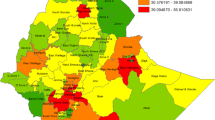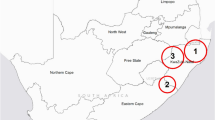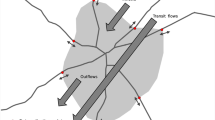Abstract
Families living in poverty in the United States rely on earnings, federal government programmes, the emergency food system (EFS) and a variety of informal networks to get adequate nutrition. The EFS is a large network of emergency food operations (EFOs) that serve as a supplement both for people receiving Supplemental Nutrition Assistance Program benefits and for those requiring food aid who do not qualify for government assistance. The static view of the distribution of EFOs across 11 counties in south-central Indiana typically employed by policymakers and non-governmental organizations shows this largely rural area to be well covered. However, when examined by the time of day and day of month that EFOs in the region operate, coverage proves illusory. Here, we map and analyse the spatiotemporal availability of services offered by these EFOs and develop measures of availability of EFOs, dependent on EFO open hours, service area limitations and numbers of food-insecure individuals. This allows policymakers and non-governmental organizations to better gauge the adequacy of the EFS within a given region.
This is a preview of subscription content, access via your institution
Access options
Access Nature and 54 other Nature Portfolio journals
Get Nature+, our best-value online-access subscription
$29.99 / 30 days
cancel any time
Subscribe to this journal
Receive 12 digital issues and online access to articles
$119.00 per year
only $9.92 per issue
Buy this article
- Purchase on Springer Link
- Instant access to full article PDF
Prices may be subject to local taxes which are calculated during checkout





Similar content being viewed by others
Data availability
The data that support the findings of this study are available from the corresponding author upon request or at https://cfslab.weebly.com/data.html.
References
American Factfinder (US Census Bureau, 2019); https://factfinder.census.gov/faces/nav/jsf/pages/guided_search.xhtml
Gundersen, C., Dewey, A., Crumbaugh, A., Kato, M. & Engelhard, E. Map the Meal Gap. Feeding America http://map.feedingamerica.org/ (2015).
Food Security in the U.S.—Measurement (US Department of Agriculture Economic Research Service, 2019); https://www.ers.usda.gov/topics/food-nutrition-assistance/food-security-in-the-us/measurement.aspx
Managing the Month on Food Stamps (Common Cents Lab, 2016); https://advanced-hindsight.com/blog/managing-month-food-stamps/
Poppendieck, J. Sweet Charity? Emergency Food and the End of Entitlement (Penguin, 1998).
Fisher, A. Big Hunger: The Unholy Alliance between Corporate America and Anti-Hunger Groups (MIT Press, 2017).
Coleman-Jensen, A. Food Pantries Provide Emergency Food to More than One-Quarter of Food-Insecure Households (US Department of Agriculture Economic Research Service, 2018); https://www.ers.usda.gov/amber-waves/2018/november/food-pantries-provide-emergency-food-to-more-than-one-quarter-of-food-insecure-households/
Vissing, Y., Gu, J., Jones, A. & Gabriel, S. Preserving dignity in the face of hunger: a study of food pantry utilization. Humanity Soc. 41, 461–481 (2017).
McEntee, J. C. & Naumova, E. N. Building capacity between the private emergency food system and the local food movement: working toward food justice and sovereignty in the Global North. J. Agric. Food Syst. Comm. Dev. 3, 235–253 (2016).
Wilson, N. L. W., Just, D. R., Wansink, B. & Swigert, J. Food pantry selection solutions: a randomized controlled trial in client-choice food pantries to nudge clients to targeted foods. J. Public Health 39, 366–372 (2017).
Rural Poverty & Well-Being (US Department of Agriculture Economic Research Service, 2019); https://www.ers.usda.gov/topics/rural-economy-population/rural-poverty-well-being/
O’Connell, K. E., Holben, D. H. & Holcomb, J. P. Use of food pantries is associated with household food insecurity in Ohio. J. Hunger Environ. Nutr. 2, 93–109 (2007).
Molnar, J. J., Duffy, P. A., Claxton, L. & Bailey, C. Private food assistance in a small metropolitan area: urban resources and rural needs. J. Sociol. Soc. Welf. 28, 187–209 (2001).
Waity, J. F. Spatial inequality in access to food assistance in Indiana. Socio. Inq. 86, 103–126 (2016).
Widener, M. J. & Shannon, J. When are food deserts? Integrating time into research on food accessibility. Health Place 30, 1–3 (2014).
Data Set #1: South Central Indiana Food Pantries (Critical Food Studies Lab, 2018); https://cfslab.weebly.com/data.html
Mousa, T. Y. & Freeland-Graves, J. H. Impact of food pantry donations on diet of a low-income population. Int. J. Food Sci. Nutr. 70, 78–87 (2019).
Wright, B. N. et al. Daily dietary intake patterns improve after visiting a food pantry among food-insecure rural Midwestern adults. Nutrients 10, 583 (2018).
Bradley, S., Vitous, C. A., Walsh-Felz, A. & Himmelgreen, D. Food insecurity and healthcare decision making among mobile food pantry clients in Tampa Bay. Ecol. Food Nutr. 57, 206–222 (2018).
Fong, K., Wright, R. & Wimer, C. The cost of free assistance: why low-income individuals do not access food EFOs. J. Sociol. Soc. Welf. 43, 71–93 (2016).
Kwan, M.-P. Space–time and integral measures of individual accessibility: a comparative analysis using a point-based framework. Geogr. Anal. 30, 191–215 (1998).
Mabli, J. & Worthington, J. Supplemental Nutrition Assistance Program participation and emergency food pantry use. J. Nutr. Educ. Behav. 49, 647–656 (2017).
SNAP Community Characteristics—Indiana (Food and Nutrition Service, USDA, 2018); https://www.fns.usda.gov/ops/snap-community-characteristics-indiana
Indiana’s Emergency Food Resource Network: Food Assistance Directory (Purdue Extension, 2017); https://www.purdue.edu/indianasefrnetwork/Home/Directory
Connect2Help Community Resource Network: Food Assistance Directory (Connect2Help, 2017); https://www.connect2help.org/resource-database/
Waity, J. F. Geographic variation in barriers to the usage of food assistance in Indiana. J. Hunger Environ. Nutr. 14, 511–525 (2019).
Shen, Q. A spatial analysis of job openings and access in a U.S. metropolitan area. J. Am. Plan. Assoc. 67, 53–68 (2001).
Kwan, M.-P., Murray, A. T., O’Kelly, M. E. & Tiefelsdorf, M. Recent advances in accessibility research: representation, methodology and applications. J. Geogr. Syst. 5, 129–138 (2003).
Chen, X. Enhancing the two-step floating catchment area model for community food access mapping: case of the Supplemental Nutrition Assistance Program. Prof. Geogr. 71, 668–680 (2019).
ArcGIS Desktop: Network Analyst v.10. 7 (Environmental Systems Research Institute, 2019).
Author information
Authors and Affiliations
Contributions
K.H.K. served as the principal researcher, writer and project manager. K.J.K., B.P.H., J.B. and H.F.D. provided GIS and animation products. K.M.L. provided data collection. L.P.R.P. and K.C. provided the literature review. C.V.A. and E.L.N. provided data analytics. K.R.L. provided statistical analysis. S.M.R. and D.C.K. co-developed the two indices—PAI and IAI—used here. A.M.B. and D.C.K. provided managerial support and writing assistance and underwrote the cost of this study.
Corresponding author
Ethics declarations
Competing interests
The authors declare no competing interests.
Additional information
Publisher’s note Springer Nature remains neutral with regard to jurisdictional claims in published maps and institutional affiliations.
Supplementary information
Supplementary Information
Supplementary Figs. 1 and 2, Tables 1 and 2, discussion and references.
Supplementary Video 1
Animation of pantry open hours by week, day of week and time of day.
Rights and permissions
About this article
Cite this article
Kaplan, K.H., Kirk, K.J., Lich, K.M. et al. Accessibility to emergency food systems in south-central Indiana evaluated by spatiotemporal indices of pressure at county and pantry level. Nat Food 1, 284–291 (2020). https://doi.org/10.1038/s43016-020-0079-9
Received:
Accepted:
Published:
Issue Date:
DOI: https://doi.org/10.1038/s43016-020-0079-9
This article is cited by
-
Measuring accessibility to public services and infrastructure criticality for disasters risk management
Scientific Reports (2023)
-
Assessing changes in food pantry access after extreme events
Agriculture and Human Values (2023)
-
New measures for access to emergency food
Nature Food (2020)



